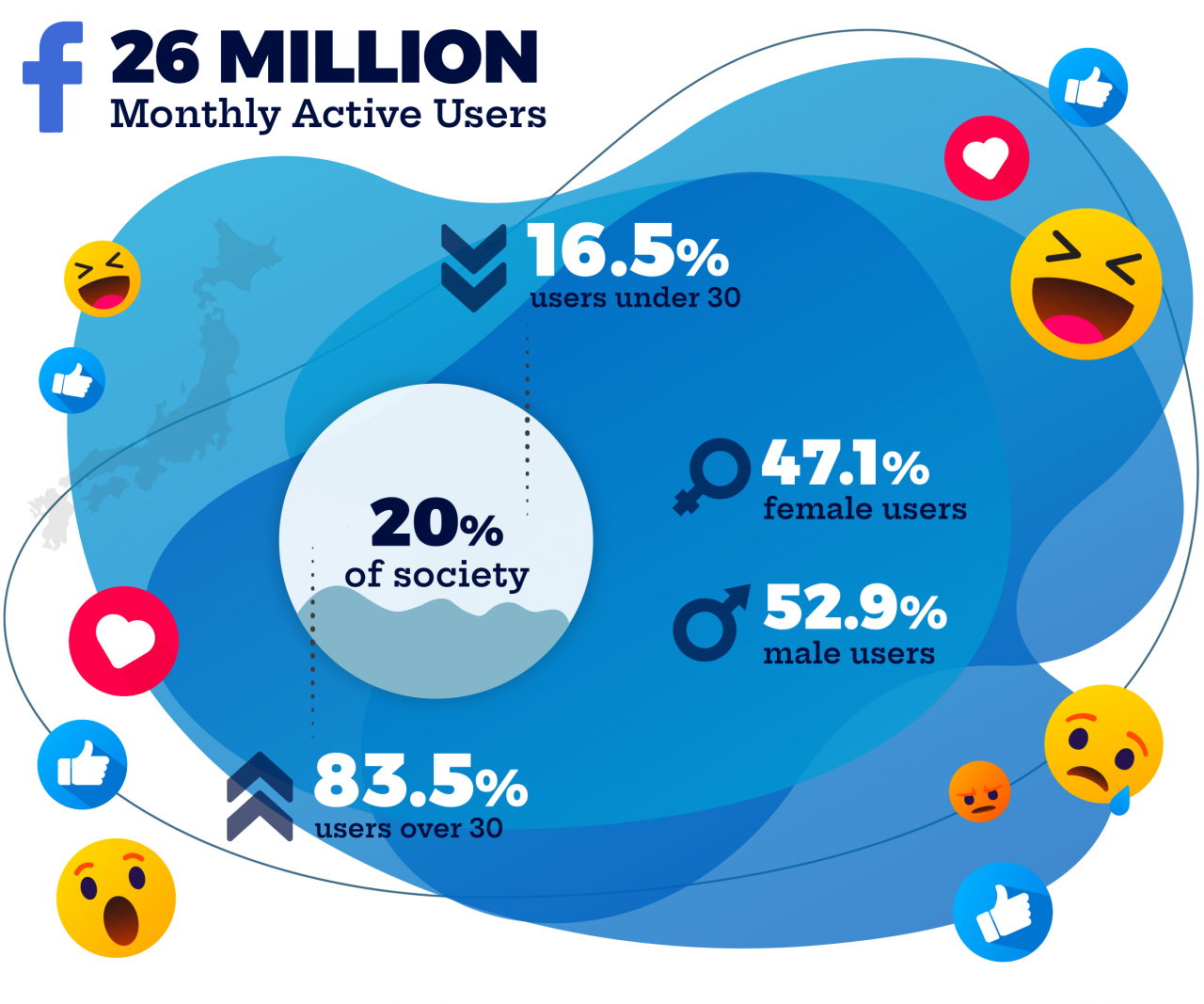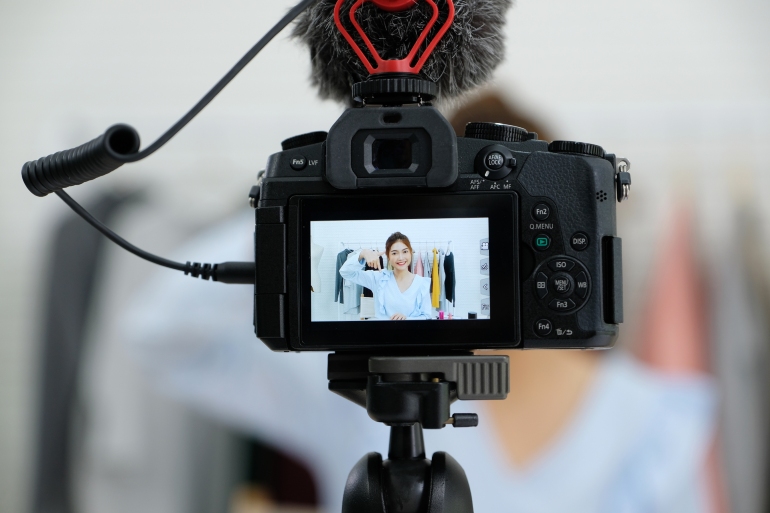A few things make the Japanese social media landscape different. And without accommodating these differences when marketing here you can seriously fail to gather the kind of momentum you need to grow your brand and promote your products adequately.
Aspects ranging from key platform characteristics; demographic trends; user behavior, and overall popularity, are all things you need to study up on before defaulting to your standard Facebook PPC tricks.
With this in mind, below is a crash course on how Facebook advertising in Japan should be approached as part of your digital marketing strategy.
Facebook’s Place in the Japanese SNS Landscape

It’s true that Japanese consumers spend a great deal of time on globally popular SNS platforms like Facebook, Twitter, and Instagram, but there are also other more local varieties that garner huge user numbers too, such as LINE.
*Tap or Hover on the graph below to see details.
If we remove the names that aren’t strictly social media platforms in the traditional sense (i.e. LINE and Youtube), Facebook is actually in third place, which might not seem too unusual. However, when you consider how Twitter has almost twice the monthly active users, while LINE has basically triple, you start to get a sense of the pecking order in Japan.
In recent years, we’ve clearly seen Facebook in Japan slowly losing relevance with more visual-first platforms like TikTok winning over users.
That said, the platform does boast 26 million users and due to its strong user base of older users it is a perfect medium for targeting professionals, families, users that have higher disposable incomes, and other businesses.
Japanese Users Prefer Anonymity
There are a few theories that try to explain why Facebook hasn’t taken off in the same way it has in other countries. One of these is that Japanese social media users are less inclined to build profiles that feature personal information about themselves, preferring platforms where they can be anonymous.
Interestingly, the Japanese Ministry of Internal Affairs of Communications published a white paper in 2018 that found that many Japanese people distrust others on social media, and are concerned about being misrepresented or hurting someone’s feelings, due to their online activities.
Platforms like Twitter easily allow users to go online using different personas and engage with communities and content without being judged by their real life friends, family or work colleagues.
One of Facebook’s strengths is how it can help you to build connections with new people through digital communities, such as online shared interest groups. However, Japanese users are much less likely to use SNS platforms to build new friendships and connections with real people, instead preferring to use them for other purposes like entertainment or to stay up to date with current affairs.
Facebook Caters to an Older Audience
*Tap or Hover on the graph below to see details.
Facebook caters to an older population in Japan, with user demographics skewed towards those who are over 30. The number of users in this bracket has increased from 79% to 83.5% between 2020 and 2021, while the number of users in their teens and twenties decreased from 21% down to 16.5%.
There is also heavy usage of the platform for business and work-related purposes, whether that’s connecting with colleagues or establishing an online base for a company or service. As such, many compare the function of Facebook in Japan to that of LinkedIn in the rest of the world.

Facebook caters to an older population in Japan, with user demographics skewed towards those who are over 30. There is also heavy usage of the platform for business and work-related purposes, whether that’s connecting with colleagues or establishing an online base for a company or service. As such, many compare the role of Facebook in Japan to that of LinkedIn in the rest of the world.
Read Our 2021 Breakdown of Japan’s Top Social Media Network
Is Facebook Advertising Still Worth It After the iOS14 Update?
Apple now requires all apps in the App Store to show a prompt to its users on iOS devices, essentially asking the user for permission for the app to track them outside the platform in different ways.
This new iOS 14 policy prohibits certain data collection and sharing unless people opt into tracking on iOS 14 via this prompt. This has changed this massively.
Important Changes – Targeting, Reporting and Optimization
- As the vast majority of iOS users are opting out of tracking, this means your retargeting audiences are going to be much smaller.
- Facebook is less able to track user behavior and the impact of its ads. We’ve seen inaccurate reporting of conversion as well as poorly performing remarketing efforts.
- Your ability to create hyper-personalized ads is reduced, which can mean your ads become more generic and less efficient.
- Facebook has now removed the 28-day attribution setting and advertisers must now rely on a 7-day window to track conversions. This can severely limit the amount of sales you see on the Facebook Ads system as those reacting to your ads 8 days onwards won’t be included in data.
- When it comes to ad reporting data, there is now a three-day delay on data delivery from iOS 14.5 users
Actions to Take When Using Facebook Advertising in Japan
Facebook still has a huge amount of data you can use for re-engagement audiences. Targeting people based on activity within the app such as content views, likes or video watches can still be effective. Using other data sources to create audiences is also recommended, such as custom audiences based on emails/phone numbers.
One of the best ways to increase your performance is to develop better ad creatives targeted at specific Japanese audiences. And to generate added engagement, study up on the different holiday dates and special activities that take place throughout the year in order to craft messages that synchronise with these events.
We’ve also seen user generated content perform well, which, when opening in Japan, has the added benefit of proving to new audiences that you have a good Japanese reputation and have products and marketing that is localized for your new audience. Examples of this could be customer reviews, unboxing videos, or lifestyle videos featuring your products.
Important Japanese Holidays
| New Year’s Day (Ganjitsu) | January 1 |
| Adult’s Day (Seijin-no hi) | The second Monday in January |
| National Foundation Day (Kenkoku Kinen-no hi) | February 11 |
| Emperor’s Birthday (Tennou Tanjoubi) | February 23 |
| Vernal Equinox (Shunbun-no hi) | March 20 or 21 |
| Showa Day (Showa-no hi) | April 29 |
| Constitution Memorial Day (Kenpou Kinenbi) | May 3 |
| Greenery Day (Midori-no hi) | May 4 |
| Children’s Day (Kodomo-no hi) | May 5 |
| Marine Day or Ocean Day (Umi-no hi) | The third Monday in July |
| Mountain Day (Yama-no hi) | August 11 |
| Respect-for-the-Aged Day (Keirou-no hi) | The third Monday in September |
| Autumnal Equinox (Shuubun-no hi) | September 23 or 24 |
| Health/Sports Day (Taiiku-no hi) | The second Monday in October |
| Culture Day (Bunka-no hi) | November 3 |
| Labor Thanksgiving Day (Kinrou Kansha-no hi) | November 23 |
Get to Know Your Audience Better
While the Japanese population shares a number of commonalities including language, race, ethnicity, education, cultural attitudes, and social awareness, marketing to the Japanese population without segmentation and personalised messages would be a huge mistake.
Successful social media advertising in Japan requires you to know your audience well and deliver content that matches specific interests and preferences.
What’s Your Objective?

Before you create an ad, Facebook lets you choose a primary objective. This means it will do its best to deliver ads based on what you want people to do when they see your ads, whether that’s click through to other pages or links for your brand, download an app or consume your promotional video content.
If you’re new to Japan, you might enjoy a certain amount of reassurance from this kind of autopiloting. While there are multiple configurations you can play with on Facebook to further coax specific outcomes from social media users, you can choose the below objective options to help you easily gain traction in the core areas that matter.
Brand Awareness
Choosing brand awareness as your primary objective will help you to generate interest in your product or service by reaching as many people as possible within your target audience. As a way to get your name out there and start showcasing your product’s benefits and attributes, it can be a good way to start courting the local market.
Use this objective when you want to:
- Increase people’s awareness of your business, service or brand
- Show your ad to as many people as possible in your target audience
HB Pro Tip: When striving towards greater brand awareness through Facebook advertising in Japan, especially in a market that is so big, it’s easy to target too widely. We recommend grounding your efforts in key parameters so your voice doesn’t get lost. To do this, ask yourself what common interests, demographic characteristics or behavioral traits your audience should have in order to actually convert further down the road. We’ve found that by always anchoring brand awareness campaigns with key features like this, we can make sure we’re always building awareness among individuals who are likely to remember our messages, and contribute to our long-term goals.
Traffic and Consideration

The consideration objective is designed to get people to start thinking about your business and look for more information about it. You may already have a great landing page with informative content about your products, or perhaps your app store listing says it all, but to get people here in the first place, traffic focused ads can help to target users who are likely to be enticed into clicking through to these pages.
Use this objective when you want to:
- Drive people from Facebook to your landing pages, blog posts or app store listing
- Gather engagement for your published content (blogs, posts, articles, pages, videos) and generate likes, comments and shares to amplify your reach
- Send people to your ecommerce platform of choice where they can buy your products
- Collect user information and leads for newsletters from people who are interested in your product
- Connect with existing or potential customers and foster greater interest for your brand
HB Pro Tip:
At Humble Bunny, we love SEO and all the amazing things it can offer, but even with the most effectively optimized landing pages and ecommerce websites, it still takes time to get people there in the first place through organic methods alone. That’s why we advocate the use of traffic campaigns as an excellent way to drive considerable volumes of potential customers to your website and landing pages. As long as your pages and sales funnel are well structured to support the user journey, your ad spend for traffic campaigns can go a very long way.
Finally, don’t miss out on the chance to implement retargeting ads to further connect with potential customers based on the different stages of the sales funnel they’re at, whether that’s browsing your product pages, reading your blog content or watching your videos. By initiating different messages and upsells to specific groups, you can better influence your users based on their specific needs.
Conversions
The conversion objective encourages people interested in your business to buy or use your product or service. For example, Facebook can help you to target Japanese users who are more likely to visit your online store and make a purchase, rather than those who will simply view your content and move on.
If you’re feeling the pressure to start generating some sales from your Japanese activities, this is probably the best foot forward. However, just be aware of the major impact the iOS update has had on conversion tracking capabilities.
HB Pro Tip: Our not-so-secret key for achieving conversions in the Japanese market is: relentless testing. The true power of Facebook Ads is revealed through extensive target and message testing. If your ads are not converting in the Japanese market, consider adapting your audiences so you are giving the platform a helping hand in finding the right audiences for your ad content.
Go Beyond the ‘Single Image’ Ad

Having access to a huge variety of advertising options is great, but sometimes this can feel overwhelming when first setting up your campaigns for Japan. While we use several ad types and combinations of formats as part of our process of improving the customer journey, some of our most favourite (and effective) ad types include the following.
Video Ads
Also, video content proves to be over 40% more engaging than stale images on Facebook in Japan. Video ads are a powerful way to connect with Japanese users who don’t know who you are (yet). To make a connection with people and draw them in with sound, emotion, and movement, you can deliver video ads in a number of locations within the Facebook platform. This includes stories, feeds, and in-stream.
Many great tests have been conducted to compare the performance of video ads to static image ads, such as the one by Biteable. Using the same target audience group, spend, and objective, results from their experiment showed that when compared to their image ads, video generated triple the amount of leads, 480% more clicks, and a 280% reduction in their cost per lead.
These video ads are also a crucial part of many successful retargeting campaigns. By retargeting ads at your ideal audience based on how long someone has watched your video, you can increase your relationship building potential following any brand awareness campaign that features video content.
Multi-Product Ads (Carousel Ads)
A favourite for ecommerce brands and fashion retailers, multi-product carousel ads are perfect for showcasing your top bestsellers, or offering users visual variation to deepen their understanding of your offerings.
This kind of ad displays up to three product images in the same ad unit with a separate title, description, and link destination for each image. It is particularly effective when combined with custom audiences from your website’s product pages to increase click through rates.
Facebook will automatically evaluate users and place the specific product image it thinks will perform the best in the first place of the carousel. This will make it more likely for people to see the ads they’ll like, and click through to your page.
Contact Us for Help with Your Japanese PPC Strategy
Best Practices for Using Facebook Advertising in Japan

Among many of the best practices and insider tips we’ve picked up over the years, below are some of the most important for brands using Facebook advertising in Japan for the first time.
Adjust Your Audience Targeting
Always make sure you have an accurate customer persona and keep working to refine it as you go. There are so many features on Facebook to help you reach your ideal customers, but you’ll need to frame your activities with a clear idea about who you want to connect with. You can customise your audiences based on things like location, age, gender, interests, and connections.
Going beyond this, leverage Facebook’s robust targeting features to truly maximise your reach. You can use advanced targeting to exclude people who are connected with certain irrelevant pages, apps, or events, for instance. You can also implement a custom audience to give Facebook a more comprehensive understanding of who you want your ads to target.
These custom audiences can be created by uploading a list of current customers or leads, or installing Facebook’s tracking pixel onto your website to build an audience from the kinds of people that have already visited you and browsed your pages.
Leverage Facebook’s robust targeting features to truly maximise your reach. You can use advanced targeting to exclude people who are connected with certain irrelevant pages, apps, or events.
Adapt Your Strategy to Life Post-iOS14 Update!
There has no doubt been some significant impacts on Japanese Facebook advertising campaigns, especially if your approach heavily depends on pixel-based conversions. Adapting your approach today (in line with some of the recommendations we’ve made above) is such an important part of succeeding on this platform today.
Focus On Fan Communities and Business Groups
When creating content for organic growth on Facebook in Japan, it can be really effective to focus on the various fan communities and business groups that are extremely popular among Japanese Facebook users. This can involve targeting users interested in a particular topic, business area, industry, or aspect of culture.
Create Detailed and Informative Ads
Many newcomers to Japan have remarked on how ‘busy’ Japanese ads can seem compared to those they are used to. This comes down to the fact that Japanese consumers are more likely to appreciate ads that offer them a great deal of information and detail upfront (and in one go). This can result in greater amounts of text featured on a small canvas.
While platforms like Facebook and Instagram have set rules about text usage and how written information should be balanced with imagery, an important takeaway is that Japanese users will naturally appreciate detailed information, accuracy, and clarity rather than purely aspirational or conceptual ads.
Focus On the Details
Taking note of the small things and focusing on details will show your audience that you’re invested in the Japanese market and that your products and services are high quality.
Consumers are extremely sensitive to how you present yourself here, and making sure that you accurately portray yourself with sufficient detail through your videos, images, and ad copy will reduce the chance of users misinterpreting you. The last thing you want is to appear irrelevant, low quality, or even disrespectful to those you’re trying to impress the most.
Differentiate Between Instagram and Facebook

As you can easily manage both of these platforms within your Facebook ads manager account, be careful not to simply apply one strategy to both uniformly. It’s crucial that you differentiate your ads strategy between Instagram and Facebook based on the unique characteristics of each platform.
While Facebook is better for direct response advertising and drawing attention through interesting links and information, such as blog posts, articles or news, Instagram focuses on the quality of aesthetics drawing brand awareness through more aspirational conten. Long text descriptions or articles obviously don’t perform the best here, unless they’re accompanied by an attention-grabbing image that helps tell the story.
There is of course crossover between these platforms, but knowing the fundamental difference is important for suitably distributing your efforts, and budget, to achieve the best results across your overall marketing strategy for Japan.
Do I Need to Work with a Local Digital Agency in Japan?

There are several pitfalls that Western brands often fall into without sufficient Japanese support. We’re not saying it’s compulsory for all companies entering Japan to work with a local agency, but it could help you grasp the various cultural nuances and contextual implications of the Japanese language and context, which can help you to reach more people.
One of the best ways to make sure you build Facebook campaigns that are 100% optimized for the local market and have the best chance of achieving the results you need is to work with a team of native speakers who are well versed in the world of Facebook advertising in Japan.
More than anything, this could give you the much-needed edge to build a sense of trust and reliability with your potential customers. And considering the homogeneous nature of the nation and the natural skepticism for new brands, this can help you with your first encounter of the Japanese consumer landscape.
Next Steps for Facebook Advertising in Japan
The declining relevance of Facebook in Japan, in addition to the impact of the recent iOS14 updates, have prompted caution among businesses using or planning to use Facebook Ads to build presence and drive sales in Japan.
Having said this, Facebook continues to be an important social proof tool. It is also a great channel for targeting older users and those who are unlikely to migrate to newer platforms like TikTok. Businesses targeting their products at adults over 30 as well as businesses should still factor this platform into their approach when entering the Japanese market.
Our final words of advice would be to pay very close attention to how they perform once they’re launched. A constant process of testing, analysis, and optimizations will allow you to gather the conclusive data you need to make important (and impactful) decisions for your brand.